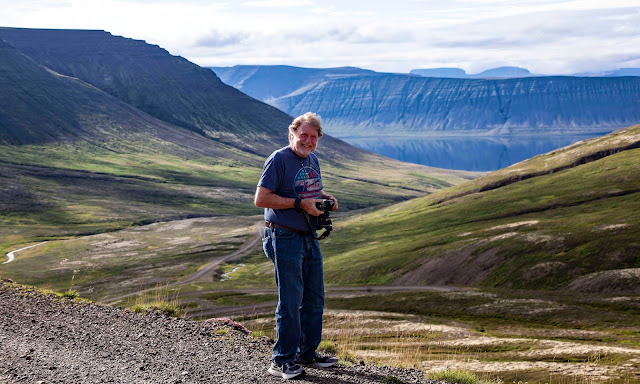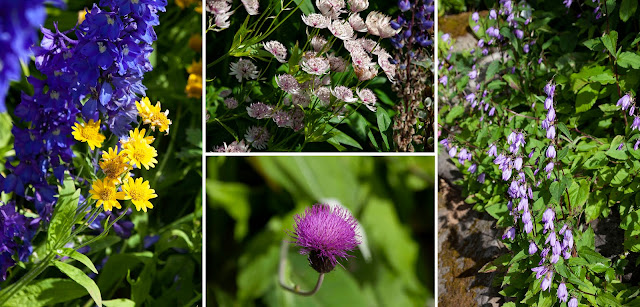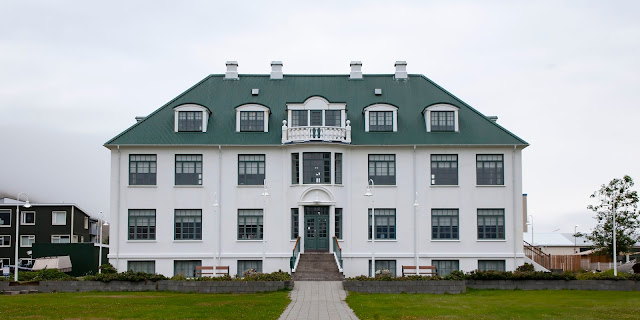 |
| Heading out to see more fjords |
 |
| My map was my bible |
Remember, we had left the Hringvegur and were on local Vestfirðir roads.
 |
| The beach near Brjánslækur |
I think we misunderstood the travel books that touted Ísafjörður as a winter destination. My guess is that they expect you to fly, not drive.
When Caty and I saw weather/road condition reports before we even left the states that listed roads as “impassable,” we changed our plans.
The morning drive on this trip hammered home how wise that decision was. I even texted Caty, “I am thoroughly convinced that you and I are alive today because we did not go to Westfjords.”
 |
| Scott photographing the "highway" |
 |
| Beautiful, but potentially treacherous |
 |
| You can pretty much tell who in Iceland has been to Vestfirðir |
And, steep!
Icelandic Sagas
Along the highway (and really throughout Iceland), there are markers explaining the Icelandic Sagas. I have mentioned them a few times, but not explained them.
The Íslendingasögur – also known as Sagas of Icelanders or Family Sagas – are stories based mostly on historical events that took place in the 9th, 10th and early 11th centuries, during the so-called Saga Age.
 |
| Illustration: BBC |
Written in Old Icelandic, a western dialect of Old Norse, they are the hallmarks of Icelandic literature. Focusing on genealogy, family histories and conflicts among early Icelandic settlers, they provide valuable insight into medieval Scandinavian society and pre-Christian religion and culture.
 |
| Illustration: Literary Hub |
While originally oral, many of the Íslendingasögur were written down in the 13th and 14th centuries. They are divided into five chronological groups based on when they were transcribed:
1230 to 1280 – Family Sagas
1280 to 1300 – Works that focus more on style and storytelling than history
Early 1300s – Sagas that deal with historical tradition
1300s – Fictional Sagas
While the Sagas are ancient, they still seem to be a big part of Icelandic national pride, especially in Vestfirðir.
 |
| Illustration: The Guardian |
Dynjandi
After traversing the winding road through the mountain pass, we came upon the first of Iceland’s many iconic waterfalls that we would see on our three-week journey.
 |
| A beautiful stop |
Iceland is the land of “fire and ice” known for glaciers and volcanoes. But I think waterfalls may be their biggest source of pride.
 |
| Iceland has some of Europe's most beautiful and most powerful waterfalls |
Actually, the falls is a series of six waterfalls that cascade down a stair-stepped cliff face. Dynjandi (or Fjallfoss, as it is often called) is the largest, with a drop of 330 feet. It is about 90 feet wide when it tumbles over the top, widening to 180 feet at its base.
Below it are Háifoss, Úðafoss, Göngufoss, Hundafoss and Bæjarfoss.
 |
| Hundafoss |
I hiked part of the way up, but stopped where the trail got slippery and narrow. My fear of slippery rocks is getting worse.
 |
| Bæjarfoss |
The falls were lovely, but, unfortunately, we arrived at the wrong time of day and everything was horribly backlit. I had to really work to get any photos to turn out. We talked about returning in the afternoon, but other sights and other places intervened.
 |
| A photographic challenge |
 |
| WC with a view |
Iceland has – by far – the nicest public restrooms I have encountered. Most are free, except when you get to the tourist-heavy South Coast.
Many are flush – rather than vault – toilets even in areas so remote you are surprised to even find a toilet. It’s not unusual to encounter restrooms with mirrors, hot water and heat. And, they are always clean.
Back to the Fjords
 |
| Vestfirðir: mountains and ocean |
Once we cleared Dynjandi, we were once again in the fjords, but the routes around these are different than other parts of Iceland.
 |
| The terminus of the fjord |
After Ísafjörður, the roads tend to follow the coast. I can only assume that the cliffs are just too steep here – and the place-to-place travel would be too slow.
There are dead-end roads that travel deeper into the tongues of land that form the fjords. We traveled down a few of these roads, most of which were dirt or gravel.
We did encounter a tunnel so new that it wasn’t even on our map, but opted to follow the road to see the pretty scenery.
 |
| Great lunch! |
 |
| An old building with a past |
Yes, we had picnicking supplies (a small amount) with us, but this restaurant was so much better.
Skruður Botanical Gardens
 |
| Gardens in an unexpected place |
Then, on the other side of Dýrafjörður, we ventured down one of the dead-end roads as far as Skruður Botanical Gardens, the oldest botanical garden in Iceland.
It's interesting that the oldest is so far north in such a secluded place.
It was founded in 1909 by Sigtryggur Guðlaugsson, a Protestant pastor and teacher in the nearby boarding school of Núpur. He used the garden to teach his students how to work the land, take care of plants and recognize various flora. Students helped build it.
It was tiny – just a small, fenced area with mature trees. There aren't a lot of signs, but, because there aren’t many trees in Iceland, the thicket of trees stands out, making it easy to find.
The suggested entry fee is about $2.50 per person, which you drop in a donation box. There was no staff and no other visitors and the day was gorgeous, so it was a lovely visit.
 |
| The gate is so charming |
Skruður resembles an English country garden, with flowers and herbs (Scott even picked some herbs that I cooked with later).
 |
| Pretty blooms on a pretty day |
The somewhat crooked Victorian gate looks like it could be original. It connects to the paths that correspond to the points of the compass.
 |
| Looking out from the center |
At one end is an arch made from the rib bones of a Blue Whale killed in Dýrafjörður by Norwegian whalers in 1892. A Blue Whale in a fjord! That would be a treat!
 |
| The bones show just how big the whale is; Right photo: Scott Stevens |
At the garden, I spent an inordinate amount of time photographing a very cooperative Redwing.
 |
| Redwings are common in residential and agricultural areas |
I knew it wasn’t a lifer, but I thought I didn’t have a good picture of one. It turns out that I already had some good shots from Tromsø, Norway.
 |
| I already had these shots from Tromsø (these Redwings are redder) |
But, I got some nice pictures, anyway.
 |
| He posed, but protested |
Redwings seem to be like our American Robins. Common in yards, gardens and neighborhoods.
Ísafjörður
Our home for the next two nights was Ísafjörður, the largest and most cosmopolitan town in Vestfirðir. What a beautiful town – especially on the sunny afternoon when we arrived.
 |
| A perfect day in Ísafjörður |
The term "town" in Iceland generally refers to a settlement of over 1,000 people; Ísafjörður (meaning ice fjord) is the only one in Vestfirðir that meets this criterion.
 |
| It has roads and municipal building and decorative plantings along the easements |
Ísafjörður is built on a spit of land jutting into its relatively short fjord, Skutulsfjörður, which is a side fjord off of Ísafjarðardjúp, one of Iceland’s biggest fjords. You drive in at the head of Skutulsfjörður, so it is an impressive entrance to the town.
 |
| Such a lovely town; Photo: Scott Stevens |
There is a marina, sailboats, cliffs and beautiful flowers. It has a maritime museum; two cultural centers, the Edinborg Cultural Centre and the Old Hospital; and some of the oldest buildings in Iceland, dating back to the 18th Century.
 |
| The cultural center is in an old school building |
According to the Landnámabók (Iceland’s “Book of Settlement”), the area was first settled in the 9th century. In the 16th century, the town grew as it became a trading post for foreign merchants.
 |
| "Downtown" looks very European |
The town of Ísafjörður was granted municipal status in 1786.
Fishing has been the main industry in Ísafjörður, and the town has one of the largest fisheries in Iceland. But, a severe decline in the fishing industry has led the inhabitants to seek work elsewhere, resulting in a decline in the town's population.
The harbor also serves ferries to nearby settlements as well as larger cruise ships for tourists visiting the area.
 |
| Private boats docked in the middle of town |
Scott got some sushi at a food truck that was playing obnoxiously loud and vulgar U.S. rap music ...
 |
| Beautiful food; obnoxious music; Photos: Scott Stevens |
... so I wandered around (out of earshot), admiring the rather deserted streets and photographing some local critters.
 |
| A Common Garden Spider and a White-tailed Bumblebee |
An Apartment with a Washer
Our lodging was the Sólheimar Studio Apartment, a really nice, large room with a full kitchen, luxurious bathroom, nice yard and a washing machine!
It was in the middle of a lovely residential area on the hill above town and, like so many places we stayed, it exceeded my expectations. We were able to do several loads of laundry and hang them everywhere to dry.
 |
| The apartment was on a hill above town |
 |
| Top: Eurasian Blackbird; Bottom: Redwing |
The yard had a clothesline, but iffy weather dictated indoor drying. Even though Iceland tends to be damp, all our clothes actually dried by the time we left.
The backyard entertained us with a Redwing and Eurasian Blackbird eating the strawberries growing there.
Exploring
Over our two days (one sunny, one dreary) in Ísafjörður, we explored all the nearby side fjords (Skutulsfjörður, Álftafjörður, Seyðisfjörður, Hestfjörður, Skötufjörður and Mjóifjörður).
We saw lots of water birds – the most we had encountered so far and we saw the first of just a handful of raptors – a Merlin perched right by the road that was scared away by a giant semi barreling down past us before I could get a decent photo.
 |
| The Park displays Whooper Swans, which we saw in the neighboring fjord; Left photo: Scott Stevens |
 |
| There were even stilts to play with |
 |
| Litlibær provides a glimpse into the lives of early settlers |
At first the road seemed rough and we almost turned back, but in exchange for a dirty car, we got some nice photos in a truly enchanting setting.
 |
| One of the many selfies we finally remembered to take! |
Sometimes foggy weather works against you (like when you see a Merlin) and sometimes it works for you!
 |
| The beach by the turfhouse |
 |
| Arctic Fox Centre |
One “attraction” we did visit was the Arctic Fox Centre in the tiny fishing village of Súðavík on Álftafjörður, the next fjord over from Ísafjörður. Caty and I had planned to visit had we made it to Ísafjörður.
 |
| One of the Centre's displays |
It’s a small facility that has a few displays and a very good (although quite long) video about Iceland’s Arctic Foxes.
It also has a resident Fox that we got to pet.
It was here that I learned that the best place to see them is the Hornstrandir Nature Reserve which is across Ísafjarðardjúp from the part of Vestfirðir we were in. Deserted since the 1950s, Hornstrandir is the least populated region of Iceland outside of the Highlands. The lack of people in the past few decades resulted in an explosion in flora and fauna, making it an excellent destination for wildlife, including the Arctic Fox.
 |
| Left photo: West Tours; Right photo: Guide to Iceland |
At the Arctic Fox Centre, we also learned that many scientists consider the Icelandic Arctic Fox to be a separate subspecies from the Foxes we have seen in Svalbard and Alaska. It was striking how different it looked from the one we saw near Hænuvík.
 |
| Left: Captive Fox; Right: Wild Fox; The shorter ears and nose indicate the wild one was a Kit |
 |
| A typical Icelandic Lutheran Church in a typical Icelandic setting |
Wildlife
Every turn along the fjords was gorgeous.
Black-headed Gulls ...
Whooper Swans ...
 |
| Spread out across a distant beach |
Black Guillemots ...
 |
| This was my first juvenile Black Guillemot |
European Shags ...
 |
| This one put on a show |
Meadow Pipits ...
 |
| A small, damp bird |
And, more White Wagtails ...
 |
| One of Iceland's most common birds |
I spent a long time at an overlook getting really close to a special pair of Parasitic Jaegers. They were special because they demonstrated the two very different morphs within the species: light and dark.
 |
| A distinctive tail |
They are call “parasitic” because their primary food is what they steal from other birds (a practice known as “kleptoparasitism”).
Known in Europe as the Arctic Skua, Arctic Jaeger or Parasitic Skua, this seabird’s name, "jaeger," is derived from the German word jäger, meaning "hunter.”
A stocky bird about 18 inches long, the Parasitic Jaeger nests on dry tundra and, like Arctic Terns, will fly at the head of a human or fox approaching its nest.
 |
| Pretty, lacy-looking wings |
The ones I photographed let me get very close without appearing agitated at all. I assume they did not have an active nest.
 |
| In some cases, I could walk right up to the Jaegers |
While driving along Hestfjörður, Scott spotted something odd. Was it just debris on the rocks? Or was it a dead, rotting whale? It was a dead whale.
 |
| Well, we did want to see whales! |
Fabulous Fish
Now this is an unfortunate segue, but I do need to talk about an absolutely spectacular dinner we had at Tjöruhúsið in Ísafjörður.
 |
| A delicious repast |
The small restaurant has long tables with benches and serves a nightly fish buffet. They had had to limit seating because of COVID, but we were able to snag reservations for our second night in town.
 |
| They also serve a light lunch and beer outside |
The meal was unbelievably delicious. Creamy seafood soup, and a variety of skillet preparations of halibut, cod and pollack. Dishes were curried, sauteed and sauced. Some were cloaked in mushroom sauce, some in lemon caper sauce and others in inventive presentations I can't recall but loved.
 |
| An incredible spread; Photos: Scott Stevens |
It appears the chefs (who I could see in the kitchen and looked like Viking brothers) just create new recipes every day. So, I couldn’t research a menu to refresh my memory after food stupor erased all recollection.
 |
| I mean, really!!! Photo: Scott Stevens |
There were also potatoes, veggies and quinoa, but next time I would skip all of that and just get fish.
When they had finished filling my plate, I would have sworn I couldn’t finish it all.
I finished it all.
It took all my reserve not to go back and get more. It was the best meal of the trip – and we had quite a few great meals!
I would definitely return to Ísafjörður. Heck, I might even live there!
























No comments:
Post a Comment